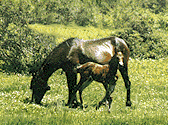...Best of Sicily
presents... Best of Sicily Magazine. ... Dedicated to Sicilian art, culture, history, people, places and all things Sicilian. |
by Vincenzo Mormino | ||
Magazine Best of Sicily Arts & Culture Fashion Food & Wine History & Culture About Us Travel Faqs Contact Map of Sicily |
Though it has often been pressed into service as a workhorse, and even butchered for its meat, the Sanfratellano boasts a distinguished pedigree. The breed has existed, in some form, for centuries. In the Middle Ages, the Arab ("Arabian") breed became popular among the Norman nobility, having been preferred by the Saracens who ruled Sicily until the eleventh century. It was a strong, if high-spirited, horse that could bear the weight of a fully armored knight, and in mountainous Mediterranean regions a battle horse's strength was often more important than a lighter horse's speed. It was for this reason that the Normans in Italy, following the example of the Visigoths in Spain, made use of the very breed favored by the Moors. (As a historical footnote, some Norman knights who fought at England's Battle of Hastings in 1066 probably rode Arabians of Sicilian stock.) Eventually, perhaps inadvertantly, the hardy Arabians were bred with local breeds descended from those used in Sicily's remote past by the Greeks and Romans. The Sanfratellano horse is identified with the northern slopes of the Nebrodi Mountains, in what is now the province of Messina. In winter and spring, this is one of Sicily's greener regions, a rugged landscape of seasonal streams, high woodlands and grasslands. The perfect place for grazing. These horses are quite versatile, adapting well to a variety of climates and conditions. Adults are robust, with an average withers height of around 158 centimetres. But are they "wild horses" in the truest sense? Perhaps not in the way that American mustangs are wild. In the realm of conjecture, however, we may observe that the Sanfratellano could live quite comfortably in Sicily were its island uninhabited by man. That could be said of many creatures. About the Author: Vincenzo Mormino is active in wildlife preservation throughout Sicily. His previous articles appear in our July and August 2001 issues. | |
Top of Page |
 They're called Sanfratellani for San Fratello, a town at the foot of the Nebrodi Mountains in eastern Sicily. Today, they're the closest thing Sicily has to "wild" horses, and a number roam in the Nebrodi Park. Black or bay, the graceful Sanfratellano is usually identified as a local breed with Thoroughbred and Oriental bloodlines, related to the local Italian breeds known as Sardinian, Murgese and Sicilian, as well as the Camargue of France and Germany. It is more distantly related to the Andalusian. There are only a few hundred Sanfratellani in Sicily. The herdbook (a kind of breeders' census) has only been kept since 1990, when the Italian government's horse breeding association took an active interest in preserving this unique breed. Worldwide, there are estimated to be fewer than 800 Sanfratellani living today.
They're called Sanfratellani for San Fratello, a town at the foot of the Nebrodi Mountains in eastern Sicily. Today, they're the closest thing Sicily has to "wild" horses, and a number roam in the Nebrodi Park. Black or bay, the graceful Sanfratellano is usually identified as a local breed with Thoroughbred and Oriental bloodlines, related to the local Italian breeds known as Sardinian, Murgese and Sicilian, as well as the Camargue of France and Germany. It is more distantly related to the Andalusian. There are only a few hundred Sanfratellani in Sicily. The herdbook (a kind of breeders' census) has only been kept since 1990, when the Italian government's horse breeding association took an active interest in preserving this unique breed. Worldwide, there are estimated to be fewer than 800 Sanfratellani living today.